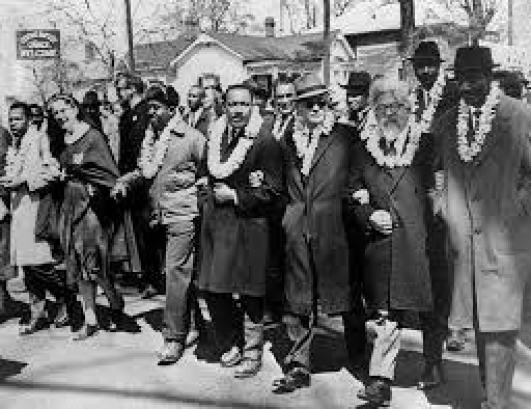Today started with us learning text, the lifeblood of our rabbinic life, the source of our authority. It is essential that we not be seen merely as liberals, or worse, “do-gooders,” who can be dispensed with as those who lead with soft hearts instead of sharp minds.
Our teacher was our colleague, the incomparable Rabbi Rachel Mikva, Associate Professor of Jewish Studies at Chicago Theological Seminary. We started with the classic text from Pirkei Avot 1.18: R. Shimon ben Gamaliel says: “The world stands on three things, on justice, on truth and on shalom.” In Montgomery, Alabama, these words strike directly to the heart. They seem more compelling and urgent than Shimon the Righteous’ claim that the world stands on Torah, Avodah and Acts of Lovingkindess.
She introduced the notion of “A Torah of Race,” building upon Rabbi Ellen Lippmann’s framing of authentic Teshuva upon core values of confession, regret, restitution and resolution. The supporting texts from tractates Ta’anit and Sanhedrin forced us to confront what we are required to do publicly to acknowledge our wrongdoing as leaders. We learned once again how a stolen beam of wood fashioned into a palace might render the entire structure illegitimate.
We could not look away from our own responsibility regarding the illegitimate structures of the society whose benefits we enjoy, often richly. We could not evade the debt we owe to those persons who were owned, degraded and denied dignity and opportunity even as our country was enriched by their forced labor.
After our shiur ended, we visited the PowerHouse, where women are cared for and protected when they seek abortions in the state of Alabama. In the midst of unrelenting harassment, Executive Director Mia Raven and her fearless clinic escorts protect women who need abortions because of their life situations.
Anti-abortion protesters try to thwart poor, needy women, mostly of color, who choose not to bring their pregnancies to term. They may need money, a bed to wait for 48 hours before the state will allow a simple D&C procedure. They receive a soothing voice and strong arms to guide them through hostile crowds of men and women who hurl curses and abuse as they walk the 30 feet from PowerHouse to the clinic.
“They have weaponized Jesus,” Mia declared to us. The irony was not lost on us. The Prince of Peace in Christianity was being employed as a vehicle of shame, hatred and violence. The stories we heard literally took our breath away and underlined that these extraordinary efforts were being taken in the name of reproductive justice, not merely rights.
We went to Selma in the afternoon, Selma of legend and dark fame. The real Selma is down to only 20,000 people, mostly African-Americans now. There we spent time with Joanne Bland, a fierce woman of color who demands respect and attention. She walked us through the events of Bloody Sunday, took us to the church where Dr. Martin Luther King, Jr. spoke to the crowds to motivate them and steel their will. She told us of her own personal experience and that of her family during those fateful days. She showed us the concrete slab where John Lewis and the other marchers stood and we each picked up a stone from that sacred place to remind us to be strong and courageous when standing up for justice, as she and all the rest of the marchers had done, even when threatened with death.
Joanne had us drive on our bus slowly, no more than 15 miles per hour, so she could point out all of the significant places of her Selma, a place of so much pain and resilience it took my breath away. After sharing with us the story of the heroes of the march and its martyrs, we finally began our walk across the Edmund Pettus Bridge, tracing the footsteps of the heroes from 54 years ago.
Though the bridge is enormous in my imagination, the actual structure is quite modest. The walk across it is positively placid. Walking slowly over the span I had to listen silently for the police sirens, the bullhorns, the anguished cries of the beaten from a half century ago. On the other side is a park and shrine and a chance to speak to another witness who was there, who gives his vivid testimony to anyone who will stand and listen.
Finally we went to the Selma synagogue, Mishkan Israel. Once a place of thriving Jewish life, it now serves four living members. The structure is from 1899 and was built in only six months. Its style is Romanesque and it is filled with rich wood and lovely stained glass. The president (the youngest of the four remaining members) shared the story of the community and his love for the building. For the 50th anniversary of the Selma march, the sanctuary was filled like it had not been for years. But the footfalls have faded and such was the uniqueness of our rabbinic visit that the local television news was there to report on it.
We prayed in the social hall and my silent b’rachot were for mercy, compassion and justice for all who had suffered as well as for the will to respond to the urgent call to combat racism that still haunts our country, North and South, today.
And I pray now – God, may our hearts and minds stiffen our backs, gird our loins and guide our hands to combat all those harm Your beloved creatures with their hatred, all who refuse to accept the simplest of our spiritual truths, that we are all one people, all from one God. We Jews declare that God is One and we are one. Could any truth be more clear or pressing today?
—
Rabbi Jamie Gibson serves Temple Sinai in Pittsburgh, PA.








